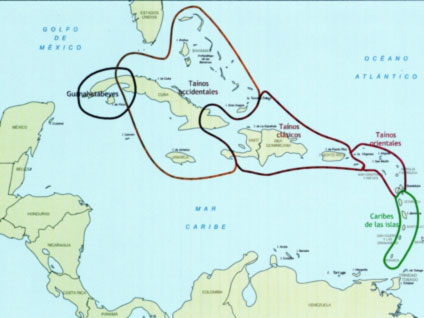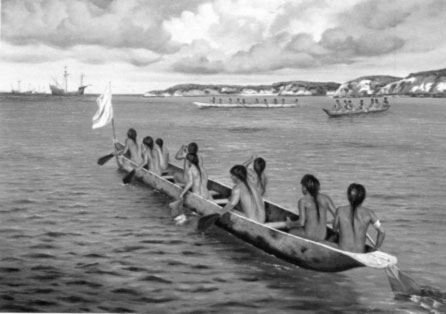|
From:TheBahamasWeekly.com Island Notes - Peter Barratt
This a synopsis of a talk given by Peter Barratt to the Institute of Mayan Studies at the Science Museum in Miami on the 19 February 2014 As you may know the TA-INO and the MAYA have the same origins - both originally having arrived in the ‘New World’ from Asia. To put migrations to the Americas into context we have the Clovis Culture in New Mexico which has been positively identified as being a settlement at the end of the last glacial period… that, in round terms, was roughly 13,000 calendar years ago. Though…none of us I am sure will be surprised if the date of the migration into the Americas from Asia will be pushed back to …possibly to 50,000 years ago. The first peoples to migrate to the Caribbean were people of the Casimiroid culture who were later driven back to far western Cuba. (They are sometimes mistakenly called Siboney). The Casimiroids entered from the Yucatan/Belize in about 4500-2000 BC possibly following a chain of cays that has long since disappeared under the sea. The Casimiroid were a lithic people who left very little in the way of artifacts, (Polish archaeologist Kozlowski put a date of 4190 BCE on one Casimiroid site in Cuba) The first and most significant migrants came from South America. The first were people of the Ortoiroid lithic culture who lived between 2000 BC and 300 BC. This map shows the five cultures that had developed in the Caribbean up to 1492. Between 500 BC up to the commencement of the Common Era there was a migration of more advanced peoples – horticulturalists - who entered the southern islands of the West Indies from South America. These people came from Saladero in the Orinoco Basin of South America. Initially they practiced ‘slash and burn’ agriculture so they were continually island-hopping northwards. Professor Rouse suggests the Barrancans who came from the same general area as the Saladoids displaced and probably inter-married with the Saladoids while island-hopping northwards…later appearing in Puerto Rico… The melding of these peoples produced Ostianoid-style pottery between about AD 500-1000. Instead of nubbins for handles the Ostinoids created very ornate ‘adornos’ (handles) sometimes featuring bats, monkeys and birds. The Ostionoid culture developed from interactions in the Caribbean region, and then travelled north and west as far as the frontier with a primitive tribe in western Cuba, and then south into Jamaica, and north into the Bahamas This slide shows how an adorno (pot handle) might have looked attached to a boat-shaped bowl. This ‘adorno’ is a good example of Z-I-C (zoned-incised- cross-hatched pottery) of the Taino Chicoid sub-series. The provenance of this adorno was SW Hispaniola and was made for the former Grand Bahama Museum
The sub-Taino culture of the Lucayans in the Bahamas excelled at making ceremonial stools for their chiefs. Experts suggest that Bahamian–made duhos were exceptionally well crafted. We understand from Spanish explorers the Ta-ino were matrilineal and some women may have outranked men… even though men had political power. They ‘held all things in common’. Some might call them socialists. The Taino made canoes of hollowed-out trees that reportedly could carry up 50 people (this is an oil painting by Alton Lowe of Green Turtle Cay who runs a museum on the cay – the oldest in the Bahamas)
The Taino diet came mainly from the sea though there are reports of them eating dogs (like the Central Americans) and also hutia a kind of rodent, birds and iguanas (iguana is another Ta íno word and incidentally very common in Bahamian place names). Most importantly (like present-day Bahamians) they ate the meat of the conch (Strombus gigas). It is fairly common in the Bahamas to find conchs that have been opened in a way unique to the Bahamian Lucayans… (that is opening one conch with the point of another) The Taino cultivated manioc/cassava… mainly the poisonous variety but they developed a way to remove the poison with a basket-ware sheath. Proven maize cultivation has been found in the Dominican Republic. One of the most distinctive stone artifacts of the Ta-íno was the three pointed stone zemi (or idol. Here is a bone vomit stick, red-on-white pottery...and a PPC (polished petaloid celt)…
The petaloid celt is sometimes called a “thunder stone” by Bahamians who thought it was formed when lightning hit the earth, it was sometimes placed under masts of sailing ships for good luck. This is part of our Taino/Lucayan collection in the Bahamas. It contains a tooth from a Lucayan, a reconstructed oval cook pot, zemis, adornos, shell tools and much Palmettoware (the local form of pottery that used conch shell as tempering).
By the time the migrants reached Antigua and Puerto Rico we have evidence they played a ball game similar to the Maya (where hands and feet were not used and the ball was always in the air). Others have been found in Dominican Repubic and Antigua. A cache of artifacts was found on the Ile de Tortue, Haiti probably of the Meillac sub-series. I urged a friend to part with his collection of seven items to me and they are now displayed in the oldest museum in the Bahamas at Green Turtle Cay. The curator Alton Lowe and Bob Carr (of Miami Circle and Preachers Cave fame) helped find a place for the artifacts…
In1492 the Lucayans saw what they thought were three very large canoes – with flapping fabric high above the waterline - all approaching the islands slowly from the east. Columbus had arrived… Columbus landed on the 10th October 1492 at the island of Guanahani (once called Watlins Island after a British pirate and now called San Salvador). A quotation from the log of Columbus explains what he saw on approaching the Bahamas: It was so uncertain a thing I did not wish to call it land. And then: The people here call this place Guanahani. I do not understand their language. They are friendly and well dispositioned people. They are neither black nor white. They ought to be good servants of good skill. For I see they repeat very quickly all that is said to them. I believe they could easily be made good Christians…. (…and…. that remark was to become a death sentence for the Lucayans) Incidentally in arriving in the Bahamas, Columbus encountered the youngest culture then existing of the Americas. Smallpox decimated well over half the population…the other half were forcibly exiled in the Greater Antilles to work on mines and plantations. The northern extremity of the migration was Grand Bahama and Abaco… go any further north and you hit Cape Hatteras. The highway of the Taino was the sea; the streets were the beaches, the lanes were the streams and inland tracks on the larger islands. 25 miles east of the City of Freeport on Grand Bahama is the Lucayan National Park. Besides having several distinct ecological zones (5 in fact) it has evidence of two Lucayan settlements and - most important - it contains a Lucayan underwater burial site.
The Lucayan National Park until quite recently had the longest charted underwater cave system in the world. The courageous divers prepared an accurate chart of the caves. And besides the caves and the burial site… the divers found a new species of remipedia, a crustation that was given the name: Spelionectes lucayensis It looks something like a swimming centipede…. This is the entrance to the burial cave (built by youth volunteers of Operation Raleigh whose patron was the Prince of Wales)
….and this is a section through the burial chamber. (Note the man on right). Underwater burial is unique to the Lucayans (there are at least four underwater burial sites in the Bahamas). I sent the cranial-deformed skull of one of the Lucayans found at the top of the tallus cone for authentication to the Smithsonian Institution. They identified the skull as belonging to a 12-year old Lucayan girl dating from about the twelfth or thirteenth century. The cranium was properly packed in a cardboard box and returned the same way.
When it was opened in Bahamas Customs in Freeport for 5 minutes the Post Office became something like a crime scene…! But perhaps the most important site on Grand Bahama was discovered at Deadmans Reef near the western end of the island. Because of sea rise (due to global warming?) a veritable factory site was exposed on the windward side of the dunes. The excavation was conducted by an archaeologist from Wake Forest and many sherds, conch tools and other items were discovered. It was less than five miles from this site that Ponce de Leon landed in 1513. It is quite possible he may have been aware of the community….
Also it was at West End that de Leon encountered ‘la vieja’…(the old Lucayan woman) who had been left by the Spaniards because she had no commercial value) Anyway, sadly the Lucayans were eliminated by European diseases and by forced migration and the sheer brutality of the conquistadores. Thus terminating the existence of what Peter Martyr and others called a truly Utopian Society. So, to conclude ….what about the parallel universe? Well we are comparing a sophisticated sedentary mainland culture with a semi-nomadic migratory culture. But there are some real similarities: Both the Mayans and Ta-íno had common Asian ancestors. There is an obvious link through the jade bead found in Grand Bahama with the Maya of Guatemala. 1* The Taíno played a ball game similar to the Maya with the similar rules and had similar collar stones 2* The rain god is similar with both cultures believing the tears of the gods became rain 3* Both cultures practiced cranial deformation 4* Both cultures used narcotics 5* They both ate (possibly) the same breed of hairless dog and corn/manioc was a staple in their diet 6* The hammock (for resting) is common to both cultures and 7* Even the effigy figures and some pottery forms are remarkably similar. Geographically the two cultures were not too far distant (separated at the nearest point by about 100 or so miles of water (between the Yucatan and Cuba) so it is highly likely they were aware of each other’s existence……. …and incidentally ‘Wikipedia’ notes the Maya traded with the Caribbean islands – and significantly did not add: citation required… So… I will end here….. and hope I have made a convincing argument for - at the very least - a tenuous TA-INO – MAYAN CONNECTION…. © Peter Barratt
|










